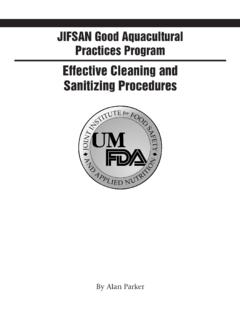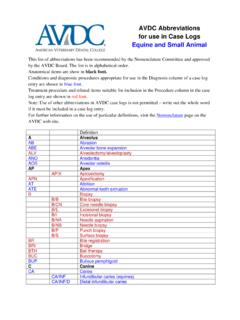Transcription of Purpose - McGan
1 Recommended Practices for cleaning and Care of Surgical Instruments and Powered Equipment The following proposed recommended practices for cleaning and Care of Surgical Instruments and Powered Equipment were developed by the AORN Recommended Practices Committee. It is being presented for public comment at this time. These recommended practices are intended as achievable recommendations representing what is believed to be an optimal level of practice. Policies and procedures will reflect variations in practice settings and/or clinical situations that determine the degree to which the recommended practices can be implemented.
2 AORN recognizes the various settings in which perioperative nurses practice. These recommended practices are intended as guidelines adaptable to various practice settings. These practice settings include traditional operating rooms, ambulatory surgery centers, physician s offices, cardiac catheterization laboratories, endoscopy suites, radiology departments, and all other areas where surgery may be performed. References to nursing interventions (I) used in the Perioperative Nursing Data Set, second edition, (PNDS) are noted in parentheses when a recommended practice corresponds to a PNDS The reader is referred to the PNDS for further explanation of nursing diagnoses, interventions, and outcomes.
3 Purpose These recommended practices provide guidelines to assist perioperative nurses in decontaminating and preparing surgical instruments and powered equipment for terminal sterilization and disinfection. These recommended practices are general recommendations, as it is impossible to make a separate recommendation for every instrument used. These recommended practices complement AORN s Recommended practices for sterilization in perioperative practice settings, 2 and Recommended practices for high-level disinfection in perioperative practice settings.
4 3 Perioperative nurses should consult these documents to assist them in providing a safe environment for the patient. Perioperative nurses are advised to review the Association for the Advancement of Medical Instrumentation (AAMI) standards for additional practice details. Information about flexible endoscope cleaning can be found in the AORN Recommended practices for endoscopes- cleaning and processing. 4 Recommendation I The manufacturer s written, validated instructions for handling and reprocessing should be obtained and evaluated to determine the ability to adequately clean and reprocess the equipment within the health care facility before purchasing surgical instruments and powered 10/29/2007 1 of 46 equipment.
5 (PNDS:I122) cleaning and handling instructions recommended by the device manufacturer vary widely. Specific types of equipment, pneumatically powered instruments, and specialty instruments can require special cleaning and maintenance 122 The manufacturer s written instructions should be used to determine how to replicate the validated cleaning and processing (PNDS:I122) manufacturer s written instructions should identify requirements related to utilities (eg, type of water, compressed air); cleaning equipment.
6 Accessories (eg, adaptors) for creating a proper connection between the instruments and equipment, utilities, and cleaning equipment; accessories for cleaning lumens, ports, and internal parts; cleaning agents;6 lubricants; and processing methods. 122 The accessories necessary to reprocess the instrument according to the manufacturer s validated instructions should be obtained at the time of purchase. (PNDS:I122) Using the proper accessories, which fit the instruments and equipment and were used during testing, provides the best opportunity to replicate validated cleaning methods.
7 Recommendation II New, repaired, and refurbished instruments should be examined, cleaned, and sterilized according to manufacturers written instructions before use in a health care organization. 98 When new, repaired, or refurbished instruments are received into a facility all moving parts, tips, box locks, ratchets, screws, and cutting edges should be examined for defects and to ensure proper working order. (PNDS:I98) Inspecting the instrument verifies that the instrument has no obvious defects and has not sustained damage during shipping.
8 10/29/2007 2 of 46 I98;I122 When indicated, new instruments should be pretreated according to the instrument manufacturer s written instructions. (PNDS:I98;I122;) Some manufacturers recommend a series of treatments in a steam sterilizer to harden the coating on the instruments before initial cleaning . When this is indicated, details are provided in the manufacturer s written instructions. New, repaired, or refurbished instruments should be decontaminated according to the manufacturer s written instruction before use.
9 Decontamination of newly acquired or repaired instruments removes any soil related to manufacturing, repair, refurbishing, or shipping. Recommendation III Borrowed or consigned (ie, loaner) instruments should be examined, cleaned, and sterilized by the receiving health care organization before use, according to manufacturers written instructions. (PNDS:I70:I77;I85;I98;I122) Parameters of in-house sterilization can be verified. If an instrument has been sterilized by another health care organization, the user will have no record of the sterilization process in the event of a recall.
10 There is a high probability of an event occurring during transport that could compromise sterility. Before receiving loaner instruments, the instrument manufacturer s instructions for handling and reprocessing should be obtained and evaluated to determine the ability to adequately clean and reprocess the equipment. When instructions are received in advance, proper conditions can be created for cleaning and sterilization before the arrival of the instruments. This can prevent a potential delay in the scheduled case and help ensure adequate sterilization.




![[Work Area] Number [Category] [Sub-category] [Competency]](/cache/preview/f/8/2/5/e/f/2/6/thumb-f825ef261389541e7266e48b77db3eb5.jpg)

![[1088] Items Needed for Survey-Sleep - ACHC](/cache/preview/c/6/7/2/a/3/f/1/thumb-c672a3f13ce8b865c4fc9f0b706a11c9.jpg)